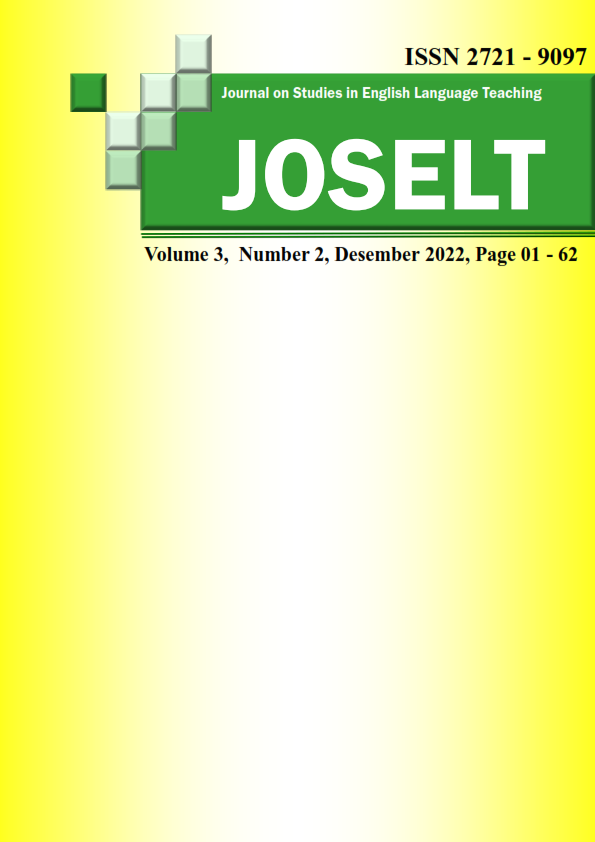THE INFLUENCE OF THE BALINESE PHONOLOGICAL SYSTEM ON EFL SOUND ACQUISITION
Keywords:
bilingual, explicit learning, phonetic representationAbstract
More evidence is needed to determine if English language sounds are influenced by Balinese EFL students. Therefore, this study attempted to examine the dominance of tonal systems in English and Balinese using dual-coding theory. This study used a qualitative approach to describe the English language of Balinese-speaking students as a segmental category. This study included 76 English students from Denpasar. The instruments consisted of a 65 English word list, a picture list, and ten sentences. The articulatory phonetic and referential techniques were used to classify each data set. Accordingly, the students activated the English system more independently but managed to translate it phonetically into Balinese. The phonetic translation, on the other hand, can be pure English, mixed Balinese, and English, or simply pure Balinese. This tendency is influenced by students' phonological awareness, learning experience, and daily practice. According to the results of this study, the four levels of English pronunciation by students are transcription, perception, phonological process, and phonetic translation. At the level of perception, the Balinese sound system is activated in English. This study suggests that English learners and teachers in Bali should use explicit learning to reduce pronunciation errors.
References
Adnyani, N. P. S., Andriani Sari, R., Dambayana Suputra, P. E., Pastika, I. W., & Suparwa, I. N. (2018). Implementing ICT-Based Phonology Learning Material Using Blend space through Classroom Action Research. Aksara, 30(2), 319–330. https://doi.org/10.29255/aksara.v30i2.76.319-330
Adnyani, N. P. S., & Pastika, I. W. (2016). Phonological Development in the Early Speech of an Indonesian-German Bilingual Child. Research in Language, 14(3), 329–350.
Amengual, M., & Simonet, M. (2019). Language Dominance does not Always Predict Cross-Linguistic interactions in Bilingual Speech Production, Linguistic Approaches to Bilingualism, 10(6), 847 – 872. https://doi.org/10.1075/lab.18042.
Boersma, P. (2001). Praat, a system for doing phonetics by computer. Glot International 5:9/10, 341-345.
Buckingham, H. W., & Christman, S. S. (2008). Disorders of Phonetics and Phonology. In Handbook of Neuroscience of Language (pp. 127–135). Academic Press.
Bungin, B. (2003). Metodologi Penelitian Kualitatif. Raja Grafindo Persada.
Clark, J. M., & Paivio, A. (1991). Dual Coding Theory and Education. In Educational Psychology Review (pp. 149–210). Plenum Publishing Corporation.
Dragger, K. (2010). Sociophonetic Variation in Speech Perception. Language and Linguistics Compass, 4(7), 473–480. https://doi.org/10.1111/j.1749-818x.2010.00210.x
Flege, J. E., & Bohn, O.-S. (2021). The revised Speech Learning Model (SLM-r. ..(ResearchGatePreprint. https://doi.org/10.13140/RG.2.2.27529.06249
Galles, N. S., & Bosch, L. (2005). Phonology and Bilingualism. In J. F. Kroll & A. M. B. de Groot (Eds.), Handbook of Bilingualism (pp. 68–87). Oxford University Press.
Harley, A. T. (2001). The Psychology of Language From Data to Theory. Psychology Press Ltd.
Kegoe, M. (2002). Developing Vowel System as a Window to Bilingual Phonology. The International Journal of Bilingualism, 6(3), 315–334.
Magloire, J., & Green, K. P. (1999). A cross-language comparison of speaking rate effects on the production of voice onset time in English and Spanish. Phonetica, 56(3-4), 158-185.
Odden, D. (2005). Introducing Phonology. Cambridge University Press.
Paivio, A. (1990). Mental Representations: A dual coding approach. Oxford Science Publication.
Paivio, A. (1991). Dual coding theory: Retrospect and current status. Canadian Journal of Psychology/Revue canadienne de psychologie, 45(3), 255–287. https://doi.org/10.1037/h0084295
Polinsky, M., & Scontras, G. (2019). Understanding Heritage Languages. Bilingualism: Language and Cognition, 23(1), 1–41. https://doi.org/10.1017/S1366728919000245
Richards, J. C., & Rodgers, T. S. (2001). Approaches and Methods in Language Teaching (Second Edi). Cambridge University Press.
Schane, S. A. (1973). Generative Phonology. Prentice-Hal, Inc.
Schwartz, G. (2020). Asymmetric Across-Language Phonetic Interaction Phonological Implications. Linguistic Approaches to Bilingualism.
Simonet, M. (2016). The Phonetics and Phonology of Bilingualism. In Oxford Handbooks Online (pp. 1–21). https://doi.org/0.1093/oxfordhb/9780199935345.013.72.
Trevor A.Harley, T, A (2001). The Psychology of Language from Data to Theory. New York: Psychology Press Ltd
Vihman, M. M. (2002). Getting started without a system : from phonetics to phonology in bilingual development. International Journal of Bilingualism, 239–254. https://doi.org/https://doi.org/10.1177/13670069020060030201
Wardana, I. K. (2014). Kesalahan Artikulasi Phonemes Bahasa Inggris Mahasiswa Prodi Bahasa Inggris Unmas Denpasar; Sebuah Kajian Fonologi Generatif. Jurnal Bakti Saraswati, 3(2), 77–87.
Yuniawan, T., Rokhman, F., Rustono, & Mardikantoro, H. B. (2018). Analysis of Types of Ecolexicon Expression in Conservation News Texts in Mass Media: Ecolinguistics Perspective. 4th PRASASTI International Conference on Recent Linguistics Research, 334–343.

